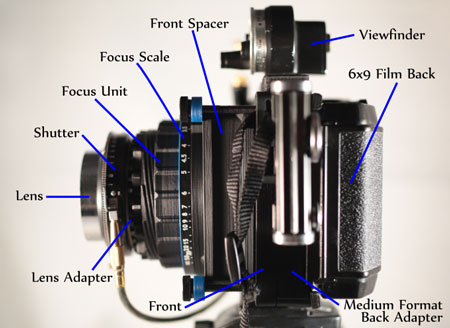Now here is a remarkable Kickstarter project: world’s first truly universal camera by Mercury Camera. They call it “a modular, open camera system capable of shooting any format (medium and large format film, digital, Instax…) and using any lens.” The claim is bold. They promise to produce the first universally modular camera. Snake oil? Too good to be true? Yes there are scams on Kickstarter, but good thing with Kickstarter is if a project doesn’t get funded you don’t owe anyone a single cent. These Mercury guys might be onto something.

What if that camera could take any of the hundreds of lenses that have been produced over the past century and longer?
What if that camera were light, portable, and inexpensive? And what if it could be easily reconfigured and adapted to do just about anything? Welcome to the Mercury.
Bold, isn’t it. Kind of a universal adapter…
Through a complex arrangement of adapters and modules, the Mercury camera is designed to take just about any lens and pair it to just about any film or digital format for which a camera back exists. The main components of the Mercury are the Front, which supports the lens stack, including focus spacers and mount adapters, and the Back, which attaches to the various film holders, packs, or digital backs.
One of the most intriguing aspects of the Mercury is that it promises to give photographers significantly more control with formats that are normally very restrictive.
The main challenge? The Mercury is designed to work primarily with medium and large format optics. DSLR lens adapters are coming for Canon and Nikon, but these lenses do not contain shutters (since DSLRs put the shutter in the camera). Modern DSLR lenses also don’t have aperture rings, so implementing an aperture control system would be necessary.
Check out the sample images on the Kickstarter page, taken with a Mercury prototype and different film backs. Here’s one:

Who is this camera for? In Mercury’s own words:
- Anyone of any experience level who wants to get back to manual controls and rediscover photography (or discover it for the first time). We will produce a series of videos and fun suggestions for the many things you can do with your Mercury (hint: just about anything available in the world of photography). We think that this camera is more fun to use than any other camera out there.
- Photographers who wish to shoot true medium format (up to 6x9cm) or large format (4×5”) for the absolute highest quality, but who also want their camera to be light, portable, and inexpensive. Few cameras exist that can shoot such huge negatives, and they all weigh so much that you wouldn’t want to bring them very many places with you.
- Connoisseurs of wide angle photography. The best wide angle lenses are true wide angles, not retrofocus lenses. Unfortunately, SLR-style cameras and most digital cameras can only accept retrofocus lenses. The Mercury is thin enough to accept legendary true wide angle lenses that were previously only usable on extremely expensive technical cameras.
- Tinkerers who want a camera that is fully modular and can be modified to suit their needs, whatever they may be. This is the ultimate camera for experimentation and design. The community wants your ideas; we all benefit when new Mercury parts are designed and shared.
- Photographers who want to free their components from proprietary camera systems. Use your Hasselblad lenses on an Instax camera, unlock the larger image circle of your Mamiya or Pentax 6×7 lenses, use a nineteenth century lens with a Hasselblad back, etc. Just about any combination is possible with the Mercury.
- Anyone who wants to contribute to a fully open, non-corporate camera system designed (mechanically and conceptually) for the future.
- Anyone who wants to shoot instant film (Polaroid/Impossible Project or Fuji Instax) but is tired of those horrible, fully automatic, flash-driven cameras that take such lousy photos. The Mercury is, without a doubt, the best camera for instant photography, allowing you to choose whatever lens is best for your style (super wide angle, portrait lens, etc.), have fully manual control over how your photograph is taken, and still retain the option of changing to other formats without having to lug around a completely different camera.
Snake oil? Let know what you think.


